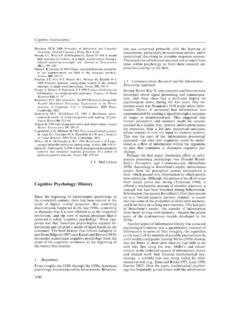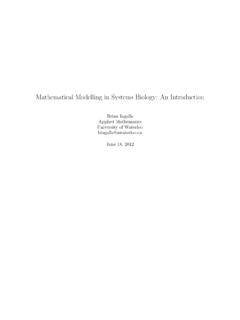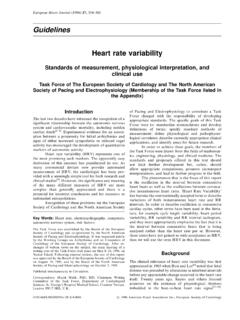Transcription of Vision: A Computational Investigation into the Human ...
1 vision . David Marr FOREWORD BY. Shimon Ullman AFTERWORD BY. Tomaso Poggio vision . vision . A Computational Investigation into the Human Representation and Processing of Visual Information David Marr The MIT Press Cambridge, Massachusetts London, England 2010 Lucia M. Vaina All rights reserved. No part of this book may be reproduced in any form by any electronic or mechanical means (including photocopying, recording, or informa- tion storage and retrieval) without permission in writing from the publisher. This book was originally published in 1982 by W. H. Freeman and Company. MIT Press books may be purchased at special quantity discounts for business or sales promotional use. For information, please email special_sales@mitpress . or write to Special Sales Department, The MIT Press, 55 Hayward Street, Cambridge, MA 02142.
2 This book was set in Garamond by Newgen. Printed and bound in the United States of America. Library of Congress Cataloging-in-Publication Data Marr, David, 1945 1980. vision : a Computational Investigation into the Human representation and processing of visual information / David Marr. p. cm. Originally published: San Francisco : W. H. Freeman, c1982. Inludes bibliographical references and index. ISBN 978-0-262-51462-0 (pbk. : alk. paper) 1. vision Data processing. 2. vision Mathematical models. 3. Human information processing. I. Title. 2010. 4 dc22. 2009048460. 10 9 8 7 6 5 4 3 2 1. To my parents and to Lucia Contents Detailed Contents xi Foreword by Shimon Ullman xvii Preface xxiii PART I. introduction AND. PHILOSOPHICAL PRELIMINARIES. General introduction 3. Chapter 1. The Philosophy and the Approach 8. Background 8.
3 Understanding Complex Information-Processing Systems 19. A Representational Framework for vision 31. PART II. vision . Chapter 2. Representing the Image 41. Physical Background of Early vision 41. Zero-Crossings and the Raw Primal Sketch 54. Spatial Arrangement of an Image 79. vii viii Contents Light Sources and Transparency 86. Grouping Processes and the Full Primal Sketch 91. Chapter 3. From Images to Surfaces 99. Modular Organization of the Human Visual Processor 99. Processes, Constraints, and the Available Representations of an Image 103. Stereopsis 111. Directional Selectivity 159. Apparent Motion 182. Shape Contours 215. Surface Texture 233. Shading and Photometric Stereo 239. Brightness, Lightness, and Color 250. Summary 264. Chapter 4. The Immediate Representation of Visible Surfaces 268. introduction 268.
4 Image Segmentation 270. Reformulating the Problem 272. The Information to be Represented 275. General Form of the 2 -D Sketch 277. Possible Forms for the Representation 279. Possible Coordinate Systems 283. Interpolation, Continuation, and Discontinuities 285. Computational Aspects of the Interpolation Problem 288. Other Internal Computations 291. Chapter 5. Representing Shapes for Recognition 295. introduction 295. Issues Raised by the Representation of Shape 296. The 3-D Model Representation 302. Natural Extensions 309. Deriving and Using the 3-D Model Representation 313. Psychological Considerations 325. Contents ix Chapter 6. Synopsis 329. PART III. EPILOGUE. Chapter 7. In Defense of the Approach 335. introduction 335. A Conversation 336. Afterword by Tomaso Poggio 362. Glossary 368. Bibliography 375. Index 393.
5 CHAPTER 1. The Philosophy and the Approach BACKGROUND. The problems of visual perception have attracted the curiosity of scientists for many cemuries. Important early contributions vvere made by Newton (1704), who laid !he foundations for modern work on color vision , and Helmholtz (191 0), whose treatise on physiological optics generates interest even today. Early in his cenrury, Wertheimer (1912, J923) noticed the apparent motion not of individual dots but of wholes, or ''fields," in images presented sequentially as in a movie. ln much the same way we perceive d1e migration across d1e sky of a flock of geese: the flock somehow con- stitutes a single entity, and is nor seen as individual birds. This observation started the Gestalt school of psychology, whlch was concerned with descrlb . ing the quallties of wholes by using terms Uke solidarity and distinctness, and with trying to formulate the "laws" that governed the creation of these wholes.
6 The attempt failed for various reasons, and the Gestalt school dissolved into the fog of subjectivism. With the death of the school, many s Background 9. Figure 1-1. A random-dOt stereogram of the type used extensively by Belajulesz. The left and right Images are identical except for a central square region that is displaced io o ne image. When fused binocularly; the images yield the impression of the central square floating in from of the background of its early and genuine insights were unfortunately lost to the mainstream of experimental psychology. Since students of the psychology of perception have made no seriOliS attempts at an overall understanding of what perception is, con- centrating instead on the analysis of properties and performance. The tri- chromatism of color vision was firmly established (see Brindley, 1970), and Lhe preoccupation with motion continued, with the most interesting devel- opments perhaps being the experiments of Miles 0931) and of Wallach and O'Connell (1953), which established that under suitable conditions an unfamiliar three-dimensional shape can be correctly perceived from onJy its changing monocuJar projection.
7 *. The development of the digital electronic computer made possible a similar discovery for binocuJar vision . In 1960 Eela Julesz devised cornpurer-genera ed random-dot stereograms, which are image pairs con- structed of dot patterns that appear random when viewed monocu larly but fuse when viewed one through each eye to give a percept of shapes and surfaces with a clear three-ctimensional srrucrure. An example is s hown ln Figure 1-1. Here the image for the left eye is a matrL"{ of black and white squares generated at random by a computer program. The iJnage for the *Tile rwo dimensional Image seen by :1 single eye 10 11Je Pbilosophy and the Approach right eye is made by copying the left image, shifting a square-shaped region at its center slightly to the left, and then proViding a new random pattern to fill the gap that the shift creates.}
8 If each of the eyes sees only one matriX, as if the matrkes were both in the same physical place, the result is the sensation of a square floating in space. Plainly, such percepts are caused solely by the stereo disparity between matching elements in the images presentt:u to ead1 eye; from sut:h experiments, wt: knuw that the analysis of stereoscopic information, like the analysis of motion, can proceed inde- pendently in the absence of other information. Such findings are of critical importance because they help us to subdivide our study of perception into more specialized parts which can be treated separately. I shall refer to these as independent modules of perception. The most recent contribution of psychophysics has been of a different kind but of equal importance. It arose from a of adaptation and threshold detection studies and originated from the demonstration by Campbell and Robson (l968) of the existence of independent.
9 Spatial- frequency-tuned channels-that is, channels sensitive to intensity variations in the image occurring at a particular scale or spatial interval-in the early stages of our perceptual apparatus. This paper Jed to an explosion of art i- des on various aspects of these channels, which culminated ten years later widl quite satisfactory quantitative accounts of the characteristics of the first stages of visual perception (Wilson and Bergen, 1979). 1 shall discuss this in derail later on. Recently a rather different approach has attracted considerable at- tention. In 1971, Roger N. Shepard and Jacqueline Metzler made line draw- ings of simple objects that differed from one another either by a three- dimensional rotation or by a rotation plus a reflection (see Figure 1-2). They asked how long it took to decide whether two depicted objects dif- fered by a rotation and a reflection or merely a rotation.
10 They found that the time taken depended on the three-dimensional angle of rotation nec- essary to bring tbe two objects into correspondence. indeed, the time varied linearly with this angle. One is led thereby to the notion that a mental rotation of sorts is actually being performed-that a mental descrip- tion of the first shape in a pair Is being adjusted incrementally in orientation until it matches the second, such adjustment requiring greater time when greater angles are involved. The significance of this approach Ues not so much in its results, whose interpretation is controversial, as ln the type of questions 1t raised. For untlJ. then, the notion of a representation was not one that visual psychologists took seriously. This type of experiment meant that the notion had to be considered. Although the early thoughts of visual psychologists were naive compared with those of the computer vis:ion community, which had had Background ]].








